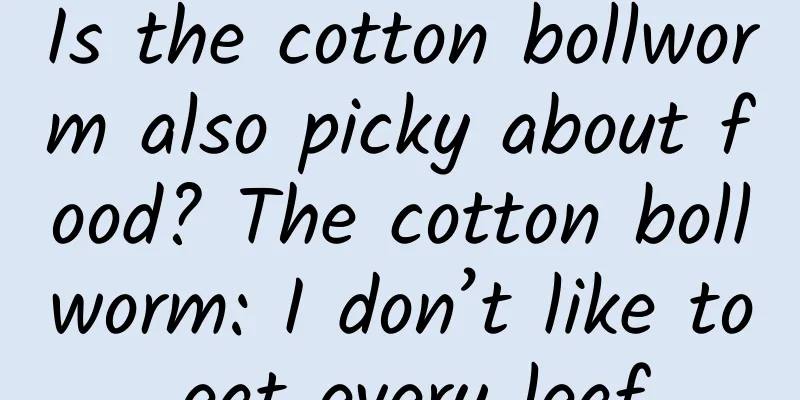Is the cotton bollworm also picky about food? The cotton bollworm: I don’t like to eat every leaf

|
Produced by: Science Popularization China Author: Bingbingbang (Institute of Zoology, Chinese Academy of Sciences) Producer: China Science Expo As the cold autumn and winter approaches, are you ready to eat a lot of delicious food to gain weight? However, in reality, some people have a natural resistance to certain foods (such as coriander and durian), which is what our mothers often nag us about. In nature, we are not the only ones who are "picky eaters". Among the thousands of species, almost every species has its own unique taste preferences. So what are the factors behind this "pickiness"? (Photo source: veer photo gallery) Recently, a research paper titled "Functional analysis of a bitter gustatory receptor highly expressed in the larval maxillary galea of Helicoverpa armigera" was published in the internationally renowned academic journal PLoS Genetics by a team led by Researcher Wang Chenzhu from the Institute of Zoology, Chinese Academy of Sciences. The paper revealed from a genetic perspective how food is selected for the cotton bollworm group. The scientific name of the cotton bollworm is Helicoverpa armigera. In the biological classification, it belongs to the order Lepidoptera, the family Noctuidae. It is widely distributed in China and around the world. It is an important borer pest of cotton during the bud and boll period. It mainly feeds on the buds of cotton and also feeds on young leaves. For most insects, the identification of plant types is mainly through the perception of the smell emitted by the plant itself, which is a mixture of various secondary metabolites produced during the growth process of the plant itself, including coumarin, a bitter secondary metabolite that can dissuade insects from feeding. Coumarin is mainly synthesized in the fruits, roots, stems and leaves of plants and is widely distributed in the plant kingdom. It can not only affect the feeding behavior of insects, but also inhibit the growth of insects and reduce the survival rate and egg-laying rate of insects. So is the basis for the cotton bollworm to choose food related to the coumarin in the plant? (Photo source: veer photo gallery) Professor Wang Chenzhu's team gave the answer in this study, proving that coumarin is indeed an important basis for cotton bollworms to choose food. Just like we humans rely on our noses to distinguish odors, cotton bollworms also have organs for perceiving odors - mouthparts. There are multiple taste receptors expressed on the mouthparts of cotton bollworms, which are responsible for the perception of different odors and substances, just as we humans can perceive sour, sweet, bitter, spicy and salty at the same time. (Photo source: veer photo gallery) After the team analyzed the transcriptome data of the mouthparts of cotton bollworm (transcriptome refers to the specific manifestation of the expression of genetic genes, i.e. DNA, in an organism), the researchers found that among the various taste receptors expressed on the mouthparts of cotton bollworm, the highest content is a receptor protein called HarmGr180, and its corresponding coding gene in the DNA information library of cotton bollworm is called harmgr180. In order to study the physiological function of the HarmGr180 receptor protein, the researchers used the Xenopus oocyte expression system and the two-electrode voltage clamp experiment to heterologously express the harmgr180 gene corresponding to the HarmGr180 receptor protein into the Xenopus oocytes, and performed electrophysiological testing on the cells. The experimental data showed that the Xenopus oocytes expressing the harmgr180 gene (with the HarmGr180 receptor protein) would have a particularly strong electrophysiological response to coumarin, while ordinary Xenopus oocytes (without the HarmGr180 receptor protein) that had not been transduced with the heterologous gene harmgr180 did not make such a strong response signal to coumarin. At this point, the relationship between the harmgr180 gene and coumarin perception has become more obvious. However, the proposal and confirmation of a scientific conclusion requires very rigorous, scientific and comprehensive experimental evidence to support it. In order to further confirm the function of the HarmGr180 receptor protein, the researchers used the currently very popular gene editing technology - CRISPR/Cas9 system (a gene knockout technology that can knock out a specific target gene from the gene of an organism. The knocked-out organism no longer expresses the gene and no longer has the protein corresponding to the gene). They successfully constructed and obtained the homozygous mutant of cotton bollworm - harmgr180-/- (the cotton bollworm after the gene mutation no longer has the ability to express the harmgr180 gene). The results of the research and testing of harmgr180-/- cotton bollworm showed that cotton bollworm larvae lacking the HarmGr180 receptor protein can no longer quickly and accurately sense coumarin and retreat from it, while normal cotton bollworm larvae can normally sense and avoid coumarin. The researchers have solved the problem from the perspectives of molecular biology, omics, electrophysiology, behavior, and other aspects. The reason behind the cotton bollworm's selection of plants is that the harmgr180 gene in the body is the driving force. It regulates the expression of a receptor protein called HarmGr180, which senses and identifies the coumarin content in plants, so that it feeds on plants with less coumarin content and effectively avoids plants with high coumarin content. This study also provides a scientific theoretical basis for the development of pest repellents and effective pest control, and provides a new perspective for the study of taste in other herbivorous insects. From the fact that cotton bollworms avoid eating plants that hurt them by expressing the harmgr180 gene to sense coumarins, perhaps we should not arbitrarily regard being picky eaters as a kind of hypocritical or disobedient behavior. It is more likely that the genetic information in our bodies believes that certain foods will cause potential harm to our bodies, and it is not recommended to consume these foods to avoid unnecessary harm to ourselves. However, with the popularization of living standards and scientific knowledge, we must learn to make rational choices when choosing food. Necessary nutrients are indispensable. A balanced and nutritious diet will make our bodies strong and our spirits full. (Photo source: veer photo gallery) I hope that each of us can have a strong body and, like excellent scientists, explore more wonderful phenomena in nature and solve more unsolved mysteries in nature in the future! |
<<: My nemesis colleague insisted on using chewing gum to help me open the coconut...
>>: Antigen test is "positive"! Just because I ate an orange?
Recommend
How to analyze data in product operations?
Today we will talk about the last element of the ...
Python tutorial "Python Zero Basics 30 Days Speed Pass" Basic Tutorial for Beginners
Training course video lecture content introductio...
China Passenger Car Association: Analysis of GAIN Price Index Trend in April 2021
The GAIN Index is published by Anluqin and is a c...
Oil prices are falling, so why did they fall to negative levels?
This article was first published by Hunzhi (WeCha...
How to do online promotion?
With the continuous development of the Internet, ...
Three Visits to the Thatched Cottage: The story of a newcomer in the workplace who paints a rosy picture for his boss!
Mixed Knowledge Specially designed to cure confus...
2015 is the year of the explosion of smart hardware: starting from CES, will there be competition, reshuffle or tragic death?
[[125541]] 2015 has come so quickly, and the exci...
NetQin plans to sell Feiliu. A good ending is the best beginning.
Recently, the news that NetQin released on its of...
A small breeze shakes a big bridge, how can it turn into a storm?!
A small breeze shakes a big bridge, how can it tu...
Science glove box: Unveiling the mysteries of space experiments
When we look up at the starry sky, in addition to...
Mark Chao turns into Statham? The new generation of RAV4 looks like it's going to be tough
Since 2016, RAV4 has been launched with a new Chi...
How to build and operate the core capabilities of membership products?
We must be familiar with membership products, but...
Eating more dietary fiber can help reduce inflammation levels in the body! Which foods have good anti-inflammatory effects?
Inflammation is the common "soil" for m...
Is myopia laser surgery suitable for most people? You may not know these taboos
The college entrance examination season is over, ...
WM Motor is recruiting strategic investors and has attracted a number of capitals to discuss cooperation
The automotive industry is very hot, and even in ...









